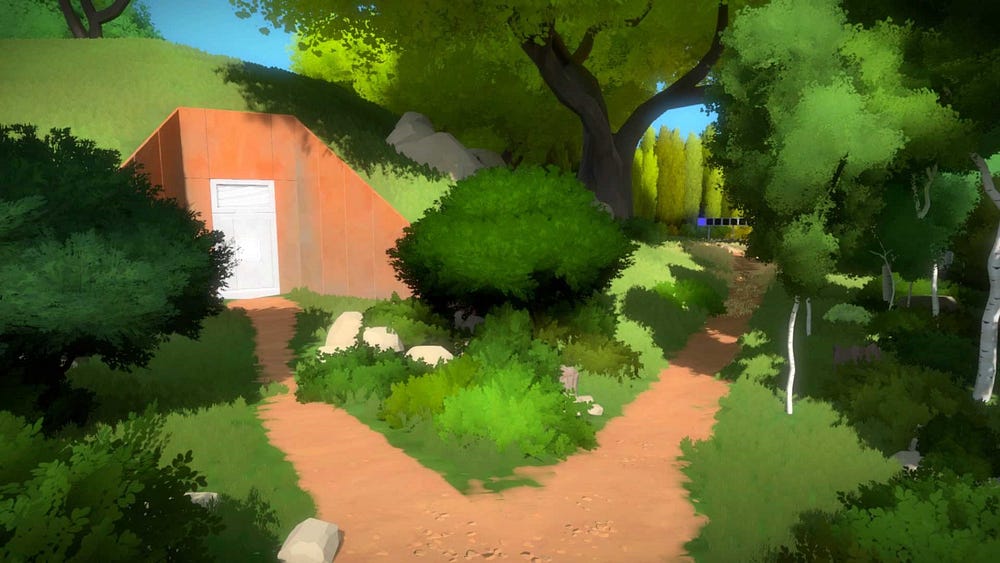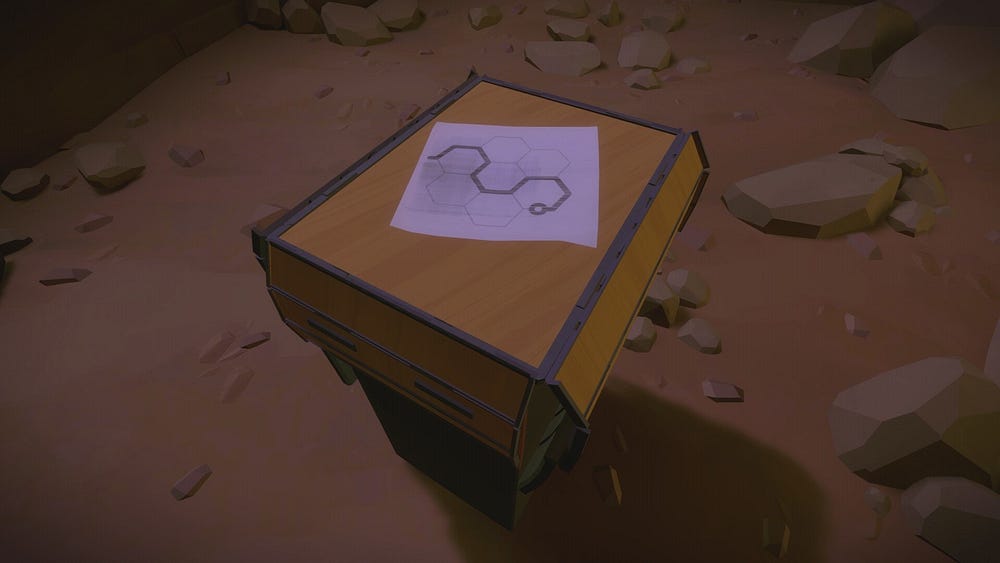In this series of articles, I analyse the games I’m currently playing and focus on a particular moment from the game that stood out to me. This article talks about the Eureka! moments in Jonathan Blow's The Witness.

In this series of articles, I analyse the games I’m currently playing and focus on a particular moment from the game that stood out to me. I will attempt to unpack my experience to figure out why the moment made an impression on me in order to inform my own design practice.
The Witness is a first-person puzzle game by Jonathan Blow (creator of Braid). I first became aware of Blow’s work through the documentary Indie Game: The Movie. I was fascinated by his take on the development process and soon after viewing the movie I played Braid and loved it. Although Braid and The Witness share similarities, they are very different games. Braid is an artistic puzzle-platformer which plays with time travel, whereas The Witness is a first person puzzle game set on a beautiful deserted island. There is one particular gaming moment that I think people will take away from this game, the one that everyone is amazed by when they discover it in The Witness, but discussing that would spoil it, so I’m going to focus on something that stuck with me long after completing the game.
There is a lot I love about this game, but one of the key take-aways for me was the games ability to produce the Aha! Or Eureka moment when the player feels the satisfaction of figuring something out and there was one particular instance of this happening to me that was right at the start of the game. Early in the game once you’ve progressed through the first set of very basic puzzles you are presented with a door. Because this is a video game, the door is locked and you need to figure out how to open it. However the lock to this door contains puzzle elements that haven’t yet been introduced to the player in the form of these small back hexagon shapes and white and black squares. As I assume many players did, I tried to unlock the door and failed as I was unsure about the rules for this puzzle.

These puzzle elements are introduced very close by and so the player is meant to play through these sections first before returning to the door. The puzzle elements are introduced in very basic puzzles that progressively get more difficult until the game is satisfied that the player now understands what they need to do with these small back hexagon shapes and white and black squares.
Once I had completed these puzzle sections I pondered on whether I would now be able to solve the puzzle that was on the locked door. I took another look and after applying my new found understanding of the small back hexagon shapes and white and black squares I was now able to solve this puzzle and the door unlocked.
Behind the door was a small cave with a single chest inside that was opened by using an ‘unlock puzzle’ — a very simple puzzle in which the player just draws a line. The chest opened and inside you see…

I had no idea what this was. Was it a map? Was it a code of some sort? It was clearly a puzzle solution, but to which puzzle I had no idea…
I took a note of the pattern and carried on playing. At some point I discovered a windmill in the central village area of the game. Inside is a cavern that travels underground. I follow it and find at the bottom what appears to be a movie theatre with a screen, projector and speakers. I didn’t really know what to make of it, but then I saw this…

Wait a minute, I said to myself, I’ve seen that pattern before. I checked the image of the solution provided by the chest earlier and it was clearly meant for this puzzle. I worked out how the solution was supposed to be solved using the image and then input the symbol.
The lights changed, the sound of a projector began to play and the screen lit up with a video clip. The clip itself was a lengthy video about Science verses the Arts and actually wasn’t that interesting, but the process leading up to it had been one of the most satisfying recent gaming experiences for me because of the games ability to present me with a puzzle, allow me to find a solution and then reward me for doing so, however the reward was the solution to an as-yet to be discovered puzzle.
Ron Gilbert, notable figurehead within adventure games states that for most puzzles the player should be presented with a problem without having an obvious solution. The Witness did this with the introduction of the door very early in the game. Although the island environment is completely open to the player, it is impossible for the player to bypass this locked door at the start of the game. A player *could* walk straight passed it, but most players will see a door and want to know what is behind it, thus discovering their seemingly non-obvious problem. You must see a door, before you have a key. It is generally established that when designing a puzzle you must follow the following steps:
1) PLAYER IS PRESENTED WITH PROBLEM WITHOUT OBVIOUS SOLUTION
2) PLAYER DEVELOPS TOOLS TO PRODUCE A SOLUTION
3) PLAYER IS REWARDED FOR SOLVING PROBLEM
In the case of The Witness, step 1 is the locked door. Step 2 is the player acquiring the knowledge to solve the puzzle-lock and step 3 is the player retrieving the solution map. However immediately after the player solves this puzzle and unlocks the door, they are presented with the opposite of this rule. As a reward, they are given a key, but have no door for it. It essentially does the opposite of these established puzzle design rules.
1) PLAYER IS PRESENTED WITH A SOLUTION FOR PROBLEM X (YET TO BE DISCOVERED)
2) PLAYER IS PRESENTED WITH PROBLEM X
3) PLAYER USES SOLUTION TO SOLVE PROBLEM X and PLAYER IS REWARDED
To be clear in the case of The Witness, step 1 is discovering the puzzle map behind the locked door. Step 2 is finding the movie theater puzzle and step 3 is inputting the solution on the map into the puzzle and playing the movie. So how did The Witness manage to break puzzle design rules and even turn this into a satisfying game experience?
I think the reason this rule-break works is because the solution for the yet-to-be-discovered problem was a reward from the first type of puzzle. In addition the fact that I had to work hard to retrieve the puzzle solution map made me regard it as something of significance. If the player had discovered the map, key, puzzle solution just laying around and then was presented with the movie theatre puzzle, the act of playing the video would have been nowhere near as rewarding and the player may not have realised the significance of the solution, potentially leading to them becoming frustrated with the theater puzzle later in the game.
As a designer and having worked on a number of adventure style games, sometimes it feels necessary to provide the solution to a puzzle before you have shown the player the puzzle itself. The Witness is a non-linear puzzle game from the point of this door and so it is impossible to know which solutions the player will find first and which puzzles the player will come across. What this door is meant to teach the player is that they may need to hunt for a solution before tackling a particular problem and occasionally the solution may be presented to the player by solving other problems (which the player may have already solved). What The Witness has shown us is that it can be okay to break traditional rules of puzzle design, but perhaps make the puzzle solution a reward for completing a puzzle that does follow this rules.
If you enjoyed this article, then consider following me on Twitter for additional updates on my games and further writings over @Stuart_Lilford
Read more about:
BlogsAbout the Author(s)
You May Also Like








